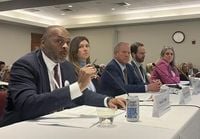Healthcare costs in the United States are climbing at an unprecedented pace, leaving businesses, employees, and families scrambling to keep up. The numbers are staggering, the policies ever-shifting, and the sense of urgency is palpable from Arizona to Massachusetts. As states grapple with the dual challenge of skyrocketing premiums and looming coverage losses, leaders and insurers are racing to find solutions that won’t leave millions in the lurch.
According to Price Waterhouse Coopers, national medical costs are projected to surge by nearly 38% between 2023 and 2026—the steepest increase in more than 15 years. AZ Blue, Arizona’s largest health insurer, is feeling the impact firsthand. Joe Greenberg, Chief Operating Officer for AZ Blue, explained, “More people are getting more care that is more expensive.” The post-COVID era has seen a dramatic uptick in medical utilization: emergency care is up 20%, inpatient care has climbed 18%, and office visits have risen 14% for large commercial groups in 2024–2025.
But it’s not just about more people seeking care. Arizona has added nearly 1,800 primary care providers, resulting in an additional 6.5 million visits—each one carrying its own set of labs, imaging, and treatment costs. Hospital revenues in the state have soared by over 10% in a single year, while specialty drugs and physician services continue to drive costs higher. Pharmacy spending, in particular, has spiked: while prescription utilization is up just 2.6%, costs have ballooned by 36%, largely due to expensive GLP-1 and specialty medications.
“Artificial intelligence is helping providers optimize schedules and capture every possible charge,” Greenberg noted. From 2022 to 2024, AZ Blue saw sepsis claims double, with nearly half lacking treatment consistent with sepsis—a clear sign, the company says, that billing practices are becoming more aggressive rather than care improving.
Policy changes at the federal level are also shaking up the landscape. The No Surprises Act, designed to protect patients from unexpected bills, has led to a flood of payment disputes between insurers and providers. AZ Blue is now managing 4,000 such disputes each month and reports that providers are sometimes awarded payments more than ten times the market average. Meanwhile, fraud and abuse continue to siphon away precious healthcare dollars, with private equity firms buying up medical practices and, according to AZ Blue, often driving up patient costs instead of improving efficiency.
To help shield employers and members from the brunt of these increases, AZ Blue has dipped into its reserves, absorbing over $500 million in unexpected claims in 2024 and 2025. The company is also cutting administrative costs by 10%, aggressively renegotiating provider contracts, and ramping up efforts to fight fraud, waste, and abuse—efforts that have saved $100 million over five years. On the care delivery side, Prosano Health sites (owned by AZ Blue) have reduced ER visits by 37%, acute hospital admissions by 7%, and specialist visits by 35% among group members in 2024. Biosimilars, too, are helping to keep pharmacy costs in check, saving over $8 million in 2025 alone.
Employers are being urged to get creative. Strategies include moving to coverage with care built-in (such as the BlueSignature Prosano Standard Group Plan, which offers a 5% premium discount), choosing smaller performance networks, modifying benefits to manage premium costs, strengthening pharmacy management, and encouraging employees with chronic conditions to enroll in health management programs. “Shielding employees from financially devastating medical events is the priority,” said Greenberg, emphasizing the need for proactive, data-driven solutions.
Yet while Arizona’s approach focuses on innovation and cost containment, Massachusetts faces a different, but equally daunting, set of challenges. Federal policy changes set to take effect in 2027—including new Medicaid work requirements and more frequent eligibility checks—are expected to strip health coverage from around 300,000 residents, according to Audrey Shelto, CEO of the Blue Cross Blue Shield of Massachusetts Foundation. That’s projected to double the state’s rate of uninsurance, a dramatic reversal for a state long celebrated for its near-universal coverage.
“This law makes it unbelievably harder to qualify for MassHealth, to get enrolled in MassHealth and to stay enrolled in MassHealth,” Shelto told the Health Policy Commission at its annual cost trends hearing. The new rules, part of the One Big Beautiful Bill Act, require adults aged 19 to 64 and those in the Affordable Care Act expansion group to work or participate in qualifying activities for at least 80 hours per month to retain Medicaid eligibility. States must also redetermine eligibility every six months, rather than annually, increasing the administrative burden for both agencies and families.
The financial stakes are high. Massachusetts, which already has the highest family health insurance premiums in the country, is expected to lose $3.5 billion annually once the law is fully implemented. The average annual cost of healthcare for a family in Massachusetts exceeded $31,000 in 2024, including out-of-pocket spending. Cost sharing per person jumped from $849 in 2019 to $1,049 in 2023, and the share of residents enrolled in high-deductible health plans has soared from 20% in 2014 to almost 50% in 2023.
David Seltz, Executive Director of the Health Policy Commission, pointed out that employers are increasingly shifting costs onto workers. “Survey results tell us that patients and residents who have high-deductible health plans are much more likely to have medical debt, and they’re much more likely to report having gone to the emergency department for a condition that doesn’t need emergency department level of care,” Seltz said.
MassHealth, the state’s Medicaid program, is rolling out a four-pronged strategy to help members retain coverage amid these changes: identifying exemptions, auto-determining compliance for those who already meet work requirements, conducting targeted outreach, and helping members connect with qualifying activities. Mike Levine, undersecretary for MassHealth, highlighted the importance of data matching to streamline renewals. “We managed to get our auto-renewal rates up by over 20 percentage points just by doing a better job of data matching and linking people to income records, so that they never had to fill out a form or get an envelope,” Levine said. “We want to do that with as many people as possible for work requirements.”
But the challenges don’t end there. Massachusetts is also negotiating the extension of its Section 1115 Demonstration Waiver, which gives the state flexibility over Medicaid policies and workforce programs. Federal immigration policies, particularly the loss of work authorizations, are straining the healthcare workforce—especially in long-term care settings. Michael Curry, CEO of the Massachusetts League of Community Health Centers, warned that the impending wave of uninsured patients is “deeply concerning,” noting that 43% of patients at health centers are on Medicaid and that the centers serve two-thirds of the state’s uninsured population.
Attorney General Andrea Campbell called for continued innovation and legislative action, emphasizing the need to monitor the entry of for-profit entities into the state’s healthcare sector and to find new solutions as federal support wanes. “Now with a federal government that is possibly making premiums higher under the ACA, making it more difficult for folks to access food, the innovation must continue,” Campbell said.
From the desert Southwest to New England, the message from business leaders, policymakers, and healthcare advocates is clear: the storm is here, but so is the resolve to weather it. The coming years will test the ingenuity and resilience of states, insurers, employers, and families alike as they navigate a healthcare system under extraordinary pressure.




